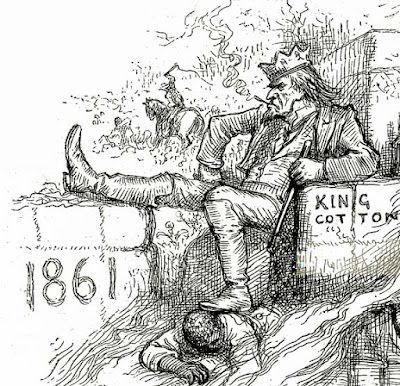Cigar brand label
Terms like Cotton Famine and King Cotton are catchy phrases that were commonplace in Civil War discussions and still resonate today.
Speculation about a cotton famine a few months after Fort Sumter in 1861.
Did the cotton famine result in fewer quilts dated during the Civil War years?
Louis Wigfall, born and raised in South Carolina was a leading
Fire-Eater, a nickname for vehement secessionists
English reporter William Howard Russell recorded an eve-of-war conversation at the attack on Fort Sumter with Fire-Eater Louis Wigfall of Texas who explained the Southern ideal of an agricultural aristocracy.
"We are an agricultural people; we are a primitive but a civilized people. We have no cities — we don't want them. We have no literature — we don't need any yet. We have no press — we are glad of it.... We want no manufactures: we desire no trading, no mechanical or manufacturing classes. As long as we have our rice, our sugar, our tobacco, and our cotton, we can command wealth to purchase all we want...."
A bale of cotton weighed about 450-500 pounds
Thomas Nast drawing
Jefferson Davis and Confederate leaders believed they held the key to winning the war in Britain's reliance on American cotton. King Cotton dictated that the Confederacy withhold cotton exports to English ports creating a Cotton Famine that would encourage Great Britain to side with the Confederacy. Former South Carolina governor James Henry Hammond summarized the principle:
"You dare not make war on cotton. No power on earth dares to make war upon it. Cotton is king!"
Union cartoon ridiculing the Manchester, England industrialists
who would support the South, choosing economics over human rights.
We tend to think that Northern blockades interrupted cotton trade between Liverpool and Charleston and New Orleans, but the main impediment was Confederate policy forbidding exports. The cotton piled up on wharves and in warehouses where it burned accidentally and deliberately or rotted away.
King Cotton Bound, American eagle subduing the King.
Note Confederate stars on the eagle's left wing;
Union stars on the right.
Both sides disrupted cotton trade.
Blockade runners defied Southern foreign policy as well as Northern ships.
John Tenniel cartoon for the English Punch showing poverty-stricken
cotton operatives looking to Britannia and the neighbors for help.
English mill closings in the early 1860s were propagandized to be the results of successful Confederate planning. Surely, the Queen and Parliament would break their neutrality policy rather than see their workers starve. But in reality, cotton mills in Northern England suffered periodic swings between prosperity and poverty and the Confederate Cotton Famine had very little to do with the grievous situation in Lancaster. British cotton brokers and the mills began the Civil War years with a surplus of cotton in storage waiting for a market revival.
John Bull observing the fraternal quarrel in the American shop.
"If you two like fighting better than business, I shall deal at the other shop."
Note the Indian shop owner with a store full of bales across the street.
Britain remained neutral and bought their cotton in India. Realizing that cotton was not King, the Confederacy changed policy to trade the commodity for English-built ships and weapons. By then English industry had recovered and the main source of their supply was India, in 1865 85% of the English cotton. Confederate cotton farming did not recover. Cotton production in 1864 yielded 300,000 bales, down from four and a half million in 1861.
Signature quilt dated 1865
The real cotton famine was in New England, which supplied much of the American calico market. Next week: A look at the price per pound and per yard.
Quilt dated 1864 from the Nebraska project & the Quilt Index.














2 comments:
This was eye-opening. I've never understood why the South couldn't "bounce back" by employing cheap labor to continue cotton production after the War. One reason apparently was the boll weevil which rampantly destroyed crops after the War, but your post reveals that the South had also lost it's market in England to Indian cotton. Interesting.
Might another reason for fewer war time dated quilts be the 250,000+ quilts made for the Sanitary Commission? Less time (perhaps less or more expensive material) to make “pretty” quilts with dates in favor of making quilts for soldiers that were used up instead of saved?
Post a Comment